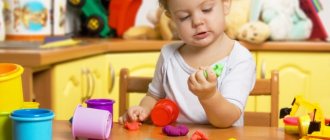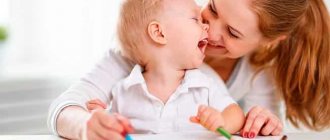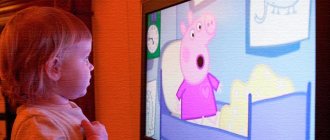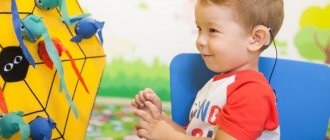Stages of development of a child’s own (expressive) speech:
Screams
- arise from birth.
Booming
– prolonged pronunciation of vowels and syllables with throat consonants (gu, agu, gee) from 2 to 5-7 months.
Against the background of a melodious hum, syllables with labial and anterior lingual sounds appear
, which then transform into babble.
Babbling
– repeated repetition of syllables, with labial and frontal consonants (ma-ma-ma, boo-boo-boo) began from 4-7.5 months.
Words
- the transition is carried out against the background of ongoing babbling: babbling words (mom, dad, bobo, bang, am, give) from 11-12 months.
The appearance of words in the adult lexicon (milk - moko, mami - take, maka - small, titiki - watch) began at 1 year 7/9 months. The coexistence of words, correctly and incorrectly pronounced, is the main pattern of the initial stages of speech development in children.
FORMATION OF PHRASE SPEECH OF CHILDREN OF YOUNGER PRESCHOOL AGE
Published in 2021, Issue No. 1(79) January 2021, PEDAGOGICAL SCIENCES | No comments yet
FORMATION OF PHRASE SPEECH OF CHILDREN OF YOUNGER PRESCHOOL AGE
Research Article
Bashirova R.R. *
GBPOU "1st MOK" Structural division "Kindergarten", Moscow, Russia
* Corresponding author (brr[at]artcollege.ru)
annotation
This article discusses the features of early speech development of children, an individual approach to non-speaking children, the use of play activities and the emotional aspect in the development of the child. Specific techniques for working with them are also revealed and various methods are offered for consideration, exercises for the development of tactile sensitivity, fine motor skills of the fingers and hands, exercises for the development of a targeted air stream and organs of the articulatory apparatus, as recommendations for parents and teachers.
Key words: early development of a child, speaking material, theatrical activities, role-playing games, development of fine motor skills, development of a targeted air stream, development of articulatory apparatus organs.
FORMATION OF PHRASAL SPEECH OF CHILDREN OF PRESCHOOL AGE
Research article
Bashirova RR *
State Educational Institution of Higher Professional Education “1st IOC”, “Kindergarten” Structural Division, Moscow, Russia
* Corresponding author brr[at]artcollege.ru)
Abstract
This article discusses the features of early speech development of children, an individual approach to non-speaking children, the application of play activity and the emotional aspect in the development of a child. Specific techniques for working with them are also revealed, various methods are proposed for consideration, as well as exercises for developing tactile sensitivity, fine motor skills of fingers and hands, exercises for developing targeted air jets and organs of articulation apparatus, as recommendations for parents and teachers.
Keywords: early child development, pronouncing of the material, theatrical activities, role-playing games, development of fine motor skills, development of a targeted air stream, development of organs of the articulation apparatus.
The relevance of research
Early age is an important period in the development of a child’s speech, and active acquisition occurs before the age of three. The lack of attention of parents to raising children leads to a delay in the child’s speech development, and in the future it becomes difficult to compensate for the lost time.
The relevance and lack of awareness of parents about various methods of interacting with a child that promote speech development determined the choice of the topic: “Early speech development and methods of working with children of primary preschool age.”
The object of our research is: the formation of phrasal speech in young children.
Subject of research : the use of various methods and techniques in the child’s play activities.
Purpose of the study: to promote the timely inclusion of parents and teachers in the process of child development, to propose the most effective methods of speech development.
Research objectives:
- Explore various areas that contribute to the child’s speech development.
- To study and determine the developmental features of young children.
Research methods:
- Explore the formation of phrasal speech through the use of various types of gaming activities.
- Observation of children to study the characteristics of speech development.
Speech is a unique opportunity for a child to communicate with his peers, however, not everyone develops it in a normal process (in a timely manner). As a result, the child becomes withdrawn or aggressive with others. Investigating the problem of speech development Ushakova O.S. [9, P. 64], was a supporter of the fact that a child needs to hear an adult’s speech. A very important aspect for the development of a child’s speech is communication between mother and child. No matter how absurd it may sound, even in cases of delayed speech development, if the mother constantly voices all actions (dressing, bathing), or rather conducts a monologue with her child, he absorbs it like a sponge. The more she comments on her actions, simply being in the kitchen with the child, talks about the process of preparing a dish, putting emotions into it and turning it into a game in which he can directly participate, the more this contributes to the activation of the child’s speech. Vygotsky L.S. [4, P. 96] believes that when mastering speech, a child moves from part to whole: from a word to a combination of two or three words, then to a simple phrase, and even later to complex sentences. The game contributes to the development of the child’s individuality and reveals the creative abilities of children [6, P. 39].
There are the following types of games:
- Theatrical games
In theatrical activities at an early age, the child acts as a spectator. It is important to teach your child to listen and understand the presentation. For example, the use of “Bi-ba-bo” dolls (which literally come to life before our eyes) evokes positive emotions and activates the child’s speech activity. Playing with Bibabo dolls expands a child's vocabulary. Helps improve the intonation aspect of speech. For example, ask your child to say the words with different intonations: bring, help, take. This whole process teaches children emotional expressiveness (joy, sadness, surprise) and develops non-verbal and verbal means of communication. The use of these methods forms the dialogical skills of preschoolers [10, P. 78].
- Role-playing games
Role-playing game is an activity in which a child imitates the actions of an adult in play moments specially created by the children themselves.
- Didactic games
A didactic game is a complex pedagogical activity, a method of teaching preschool children, when ideas about the world around them are formed through specially selected material.
- Game "Magic Ocean".
Target:
- vocabulary enrichment;
- development of fine motor skills, development of purposeful movements.
Progress of the game: a child with a fishing rod “catches objects” from the bottom of the ocean; when an object is caught, he says that
shown in the picture.
Sample: I caught the lamp. I caught the hat.
The game can be used to automate and differentiate sounds.
Rice. 1 – Game “Cook”
- Game "Cook".
Target:
- learn to form possessive adjectives;
- enrich your vocabulary with verbs: “cook”, “squeeze”, “bake”.
- learn to correctly agree adjectives with nouns.
- develop fine motor skills.
Progress of the game: The child cuts the fruit in half with a “knife” and says what he wants to cook.
Rice. 2 – Sample: I cut an apple and made apple jam
It is also very important to use not only communication, but also rely on all the child’s receptors:
- Showing and examining an object (visual perception)
- Performing an action with an object (tactile receptors)
- Requests and instructions (motor development)
- Question - answer (auditory perception)
- Communication through a toy (development of imagination)
- Repetition of what has been covered or commenting on actions (development and strengthening of memory and attention).
Many parents wonder how to get a silent person to talk? Often the reason is a lack of attention, when parents practically do not communicate with their child. But otherwise, overprotection can also cause delayed speech development, when the child only needs to point a finger and the object is already in his hand. It is important to evoke the child’s need to voice his desires, to encourage him even in moments of inaudibly pronounced sounds and syllables. Here are several methods that can be used to determine the causes of delays and ways to eliminate them.
Method 1. “Study of speech understanding”
Purpose: to identify the level of perception of adult speech.
Passive vocabulary is a set of words and expressions that a child understands, but does not use in speech due to delayed speech development [3, P. 56]. In the process of play activity, the main task of parents is to enrich the vocabulary, objects, actions, phenomena that surround children in everyday life [7, P. 24]. Ask the child to follow simple instructions, show correctly in the photo (where is mom? and where is the dog, etc.), a mirror (show nose, eyes), toys (ask to find, bring, while voicing your actions with objects), visual material (ask the child to show this or that object, or the action depicted in the picture - a person walks, crawls, stands, lies; where there is a lot - a little, big - small, etc.). But after the child has mastered and learned to correctly show objects in pictures, you need to ask him to name them.
Method 2. “Repeat and name”
Goal: to determine the level of children’s active vocabulary.
Then we smoothly move on to imitation [2, p. 73], when together with the child we perform the simplest actions and pronounce them. It is necessary to use one-syllable or two-syllable words to make it easier for your child to repeat after you.
I'm coming (hold the child's hand and walk around the room).
I run (hold the child's hand and run around the room, including the emotional aspect).
I wash (you immerse your hands in a bowl of water together, emotionally pronounce your actions, you can even splash each other).
I'm flying (raise the child in your arms and spin him in the air like an airplane).
I crawl (together with the child you crawl on the floor, whoever is faster).
I’m driving (like a train, you drive one after another - “too-too”).
According to J. Piaget [8, p. 37], children's spontaneous word creation proves the child's ability to assimilate information. Even if the child repeats the first syllable, all attempts at imitation should be encouraged.
A prerequisite is to turn the whole process into a game and the ability to interest the child
After the child has mastered the use of 1st person verbs, we teach them to use 2nd and 3rd person verbs.
I'm going, you're going, he's going.
Word combinations related to everyday activities are learned (I’m thirsty, I’m going to bed, I wash my hands, give me a doll). It is important to include high-quality adjectives in the child’s speech (big-small, cold-hot). One of the most common games is Hide and Seek. We ask the child to hide (1,2,3,4,5 hide, I’m going to look). While searching for a child, you look behind objects and say:
“behind the closet - no, behind the bed - no, under the chair - yes, I found you!” After repeated repetition, ask the child to look for you now. And at the same time pronounce it the same way as you did during the search.
Method 3. “Describe the picture”
Goal: to determine the state of contextual speech.
We transfer verbal experience to visual material. We ask the child to name the action shown in the picture.
With the help of this experiment, it is possible to identify the cause of the delay and determine the level of formation of speech development [11, P. 58]. Using these techniques allows you to quickly master speech, and turn the process itself into an exciting game.
As you know, motor development is directly related to speech. And if motor development occurs with a delay, then, accordingly, speech development is formed with a significant delay. Therefore, in the early development of a child, the formation of the child’s fine motor skills is very important [5].
- Exercises to develop tactile sensitivity and fine motor skills of fingers and hands.
- In a plate with cereal or sesame seeds, we draw various shapes with the child’s finger.
- We arrange small circles into cells according to color.
- We thread the rope into the hole of the figure to attach it to the board.
- We create various figures from plasticine.
- We run our finger over the stencil.
- We select the inserts in the desired mold.
In addition to the above, breathing exercises aimed at developing an air stream and exercises for the development of the organs of the articulatory apparatus are also recommended [1, p. 6].
- Games for the development of targeted air flow.
"Maple Leaf"
Description: We hold a thread threaded into a cut out maple leaf with our fingers and ask you to blow to make it fly.
So that the leaf will fly quickly,
Pull your lips forward.
Let's blow hard, my friend,
But without puffing out your cheeks.
"Butterfly"
Description: there is a paper butterfly on the table; you need to blow without puffing out your cheeks to make the butterfly fly.
The butterfly sat down on the table,
Blow to make it fly.
"Feather"
Description: There is a feather on the baby’s nose. We ask the child to pinch the upper lip with his lower lip and blow so that the feather flies.
"Score a goal"
Description: we ask the child to blow on the ball so that it rolls right into the goal.
- Exercises to develop the organs of the articulatory apparatus.
- Goal: development of the organs of the articulatory apparatus.
- "Horse"
Glue the tongue
On the red ceiling.
-Tsok! -Tsok!
-Tsok! -Tsok!
We pull the horse by the bridle.
- "Fungus"
Tongue on the ceiling
It turns out to be a fungus.
Promotes further production of the sound [p].
- "Cup"
Like a cup tongue
Went up to the ceiling
So that the water doesn't spill
She crept up to the lid.
Promotes further production of sounds [ш], [ж].
- "Slide"
The tongue arched the back,
It's like the cat is angry.
Promotes further production of sounds [s], [z].
Thus, when parents accompany their actions with comments, the child begins to listen, correlate words with actions, and his vocabulary and ideas about the world around him are enriched. This arouses the child's desire for communication and interaction. The use of speech therapy techniques, in which parents will take an active part, will contribute to the timely formation of speech skills in preschool children.
| Conflict of interest Not specified. | Conflict of Interest None declared. |
List of literature / References
- Bashirova R.R. Formation of phrasal speech in preschool children [Electronic resource] / R.R. Bashirova // Social network of workers.-2016.-URL: https://nsportal.ru/vuz/pedagogicheskie-nauki/library/2016/04/15/formirovanie-frazovoy-rechi-detey-mladshego-doshkolnogo (access date: 04/15/2016)
- Bozhovich, L.I. Personality and its formation in childhood [Text] / L.I. Bozhovich. – St. Petersburg: Peter, 2008. – 382 p.
- Boguslavskaya, Z.M. Educational games for children of primary preschool age: Book. For a kindergarten teacher [Text] / Z.M. Boguslavskaya, E.O. Smirnova. – M.: Education, 2001. – 245 p.
- Vygotsky L. S. Play and its role in the mental development of a child // Questions of psychology. – 1966. – No. 6.
- Zaporozhets, A.V. Preparing children for school. Fundamentals of preschool pedagogy [Text]/ A.V. Zaporozhets. – M.: Nauka, 2000. – P.250 – 257.
- Lisina, M. I. Formation of a child’s personality in communication. [Text]/ M.I. Lisina - St. Petersburg: Peter. 2009. –320 p.
- Pavlova L.N., Early childhood: development of speech and thinking [Text] / L.N. Pavlova – M.: TC Sfera, 2008. – 99 p.
- Piaget, J. Speech and thinking of a child [Text] / J. Piaget - St. Petersburg: 1997. - 124 p.
- Ushakova, O.S. Development of speech in children aged 5–7 years [Text] / O.S. Ushakova. – M.: Sfera, 2011. – 272 p.
- Elkonin, D.B. Child psychology. Child development from birth to 7 years [Text] / D.B. Elkonin. – M.: Education, 1999. – 261 p.
- Yanushko, E.A. speech development in young children [Text] / E.A. Yanushko - Irkutsk: from Mozaika-Sintez. – 64s.
List of literature in English / References in English
- Bashirova R. Formation of the phrase speech of preschool children / RR Bashirova // Social network for educators.-2016.URL: https://nsportal.ru/vuz/pedagogicheskie-nauki/library/2016/04/15/formirovanie- frazovoy-rechi-detey-mladshego-doshkolnogo (accessed: 04/15/2016).
- Bozhovich, LI Personality and its formation in childhood [Text] / LI Bozhovich. – SPb.: Peter, 2008. – 382 p.
- Boguslavskaya, ZM Educational games for children of early preschool age: KN. For the kindergarten.garden [Text] / ZM Boguslavskaya, EO Smirnova. – Moscow: Education, 2001. – 245 p.
- Vygotsky LS Game and its role in the mental development of the child // Questions of psychology. – 1966. – No. 6.
- Zaporozhets, AV the Preparation of children for school. Fundamentals of preschool pedagogy. [Text]. – Moscow: Science, 2000. – S. 250 – 257.
- Lisina, MI formation of the child's personality in communication. [Text] / MI Lisina-SPb.: Peter. 2009. -320 p.
- Pavlova LN, Early childhood: the development of speech and thought [Text] / LN Pavlova, M.: shopping center Sfera, 2008. – 99 p.
- Piaget, J. the Speech and thought of the child [Text]/ J. piaget – SPb.: 1997. – 124 p.
- Elkonin, DB child psychology. Development of a child from birth to 7 years [Text]. – Moscow: Education, 1999. – 261 p.
- Janosko, EA the development of speech in children of early age [Text] / EA Anoshko – Irkutsk: Mosaic–Synthesis. 2010. – 64c.
Growth of a child’s vocabulary from one year and older
- 1 year - 5-9 words
- 1.5 years from 20 to 40 (from different authors)
- 2 years from 50 to 200 words
- 3 years from 800 to 1000 words
- 3.5 years - 1100
- 4 years 1600 - 1900
- 5 years 1900 – 2200
Development of phrasal speech
The appearance of phrases from two lexical units (Lala bah, papa am) begins from 1 year 9 months to two years.
The emergence and development of proposals - from two years.
By the age of 3, he begins to use complex subordinate clauses, questions “why?” appear. “when?”, uses almost all parts of speech, prepositions and conjunctions.
Uses singular and plural.
By the age of four, speech is grammatically correct, suffixes and more complex phrases are used.
Further development of speech is assessed mainly not by the number of words, but by the ability to answer questions, the presence of initiative in a conversation, the construction of logical chains, the ability to compose a story from a picture, talk about an event, retell a fairy tale.
At the same time, understanding of complex grammatical structures is assessed.









